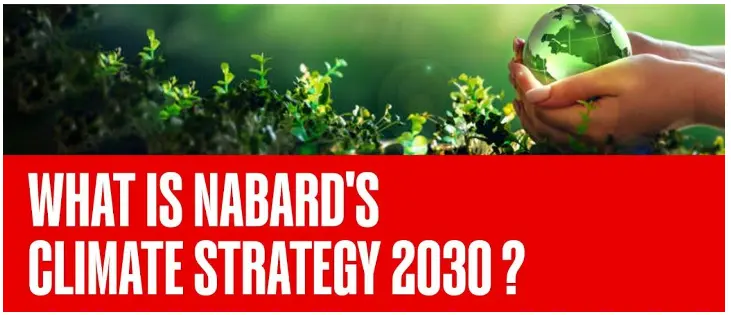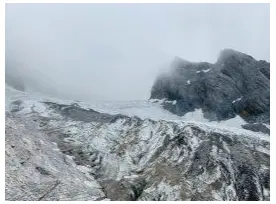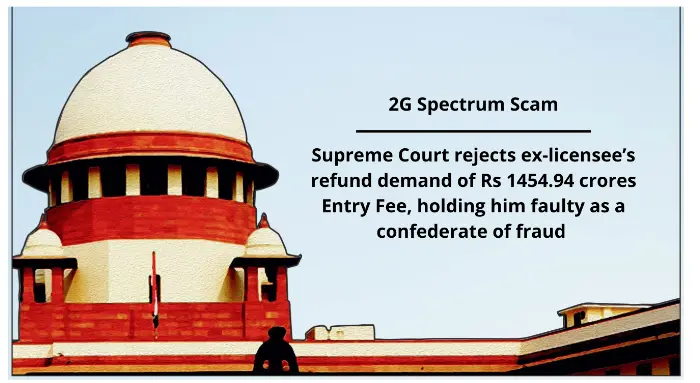Thursday, 2nd May 2024
Acceleration of Indian Ocean Warming
In News: A recent study conducted by the Indian Institute of Tropical Meteorology (IITM) in Pune suggests a tenfold surge in marine heatwaves, which could lead to the escalation of cyclones. The study indicates an increase from 20 days to 220–250 days per year.
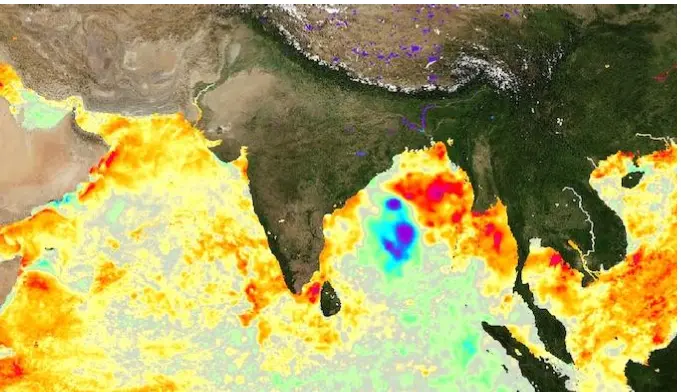
Key Findings of the Report:
- Increase in Ocean Temperature
- Rapid Warming: The Indian Ocean has experienced a temperature rise of 1.2°C from 1950 to 2020, with projections indicating a further increase by 1.7°C to 3.8°C from 2020 to 2100.
- Marine Heatwaves: Predictions suggest a surge in marine heatwave occurrences, potentially escalating from an average of 20 days per year to 220–250 days annually. These heatwaves can expedite cyclone formation and lead to prolonged heatwave conditions in the tropical Indian Ocean, posing risks to coral reefs, seagrass, and kelp forests vital to fisheries.
- Changes in Heat Content of the Ocean
- Deep Ocean Warming: The warming trend extends beyond surface waters, penetrating depths of up to 2,000 meters, elevating the overall heat content of the ocean.
- Energy Comparison: The projected increase in ocean heat content is likened to the energy output of one Hiroshima atomic bomb detonation every second, persisting for a decade.
- Sea-Level Rise and Thermal Expansion
- Thermal Expansion: The escalating heat content contributes significantly to sea-level rise, primarily through thermal expansion, surpassing the effects of glacier and sea-ice melting.
- Changes in Indian Ocean Dipole (IOD) and Monsoon Patterns
- IOD Alterations: The rise in ocean heat content is expected to affect the Indian Ocean Dipole, with projections indicating a 66% increase in extreme events and a 52% decrease in moderate events by the end of the century, impacting monsoon dynamics crucial for agriculture.
Future Outlook
Despite ongoing heatwaves, an "above-normal" monsoon is anticipated for June-September 2024, partially attributed to a positive phase of the IOD.
Impact of Rising Sea Levels on India
- Rate of Sea Level Rise: The Ministry of Earth Sciences reports an average rise of about 1.7 mm/year along the Indian coast during the last century (1900-2000), with implications for coastal inundation.
- India's Vulnerability: India faces heightened susceptibility to sea-level rise due to rapid ocean warming, with thermal expansion accounting for a significant portion of sea-level increase in the Indian Ocean.
- Implications: Compound extreme events, including intensified cyclones and exacerbated flooding, threaten India's coastal regions. Intrusion of saline water from rising sea levels affects river deltas, potentially rendering vast areas uninhabitable.
Ways to Tackle the Threat of Marine Heatwaves and Intensifying Cyclones
- Mitigation Strategies
- Emission Reduction: Advocate for emission reduction policies akin to the European Union's Emissions Trading System (ETS) to mitigate greenhouse gas emissions, addressing the root cause of marine heatwaves.
- Renewable Energy Integration: Promote renewable energy sources to reduce reliance on fossil fuels and mitigate long-term impacts on ocean temperatures.
- Early Warning Systems and Preparedness
- Advanced Monitoring: Implement advanced ocean monitoring systems like Australia's Integrated Marine Observing System (IMOS) to gather real-time data on marine heatwaves and cyclone development.
- Predictive Modeling: Utilize predictive modeling tools such as the National Oceanic and Atmospheric Administration's (NOAA) hurricane seasonal outlooks to enhance preparedness and response efforts.
- Coastal Resilience Measures
- Mangrove Restoration: Restore mangrove forests to serve as natural barriers against storm surges and protect coastal communities from cyclones, drawing inspiration from initiatives in Bangladesh.
- Infrastructure Improvements: Enhance coastal infrastructure resilience through investments in seawalls and levees, following the example of the Netherlands' robust coastal defense system.
- International Collaboration
- Data Sharing and Research: Foster international collaboration in ocean observations and research through platforms like the Global Ocean Observing System (GOOS) to deepen understanding of marine phenomena.
- Capacity Building: Provide technical and financial assistance to vulnerable nations through initiatives like the World Meteorological Organization's (WMO) Tropical Cyclone Programme, aiding in cyclone preparedness and response.
|
UPSC Previous Year Questions Prelims (2010) Q. Stiglitz Commission established by the President of the United Nations General Assembly was in the international news. The commission was supposed to deal with (a) The challenges posed by the impending global climate change and prepare a road map (b) The workings of the global financial systems and to explore ways and means to secure a more sustainable global order (c) Global terrorism and prepare a global action plan for the mitigation of terrorism (d) Expansion of the United Nations Security Council in the present global scenario Ans: (b) Mains (2017) Q. ‘Climate change’ is a global problem. How India will be affected by climate change? How Himalayan and coastal states of India will be affected by climate change? |
Source: TH
Japan’s Diplomatic Posture
In News: In the evolving landscape of geopolitics, there's a notable shift occurring as Japan, historically synonymous with post-war pacifism, enhances its military prowess. This transition holds the potential to fundamentally reshape the power dynamics not only in Asia but also on a global scale.

Key Facts About Japan’s Diplomatic Posture
Japan's Diplomatic Journey Before World War II
- Seclusion (1600s-1850s):
- For over 200 years, Japan remained largely closed off from the world to preserve social order and prevent foreign influence.
- Catching Up (1850s-1900s):
- The arrival of Portuguese Commodore Perry's "Black Ships" in 1853 forced Japan out of its self-imposed seclusion. Japan modernised its military, adopted Western technology, and renegotiated treaties to regain control of its trade and foreign policy.
- Aggressive Stance (1900s-1930s):
- Despite victories, Japan wasn't treated as a full equal by Western powers, leading to frustration and a shift towards aggressive expansionism, culminating in World War II.
Japan's Diplomatic Journey After World War II
- Following World War II, Japan embraced pacifism under US-led occupation, focusing on economic rebuilding.
- Over recent decades, Japan has shifted towards a more assertive role on the world stage.
Factors Leading to Japan's Diplomatic Posture Change
External Factors
- China's Rise: China's growing military power and assertive claims in the East China Sea have prompted Japan to strengthen its defences.
- North Korean Threat: North Korea's nuclear weapons development is a major security concern for Japan.
- Uncertain US Commitment: Japan perceives a decline in US commitment to Asian security, leading to a more self-reliant defence approach.
Internal Factors:
- Conservative Resurgence: Conservative voices in Japan advocate for a more active security role.
- Pacifist Fatigue: Some question the sustainability of relying solely on the US for security.
How Japan is Changing its Diplomatic Posture:
- Manifestations of Change:
- Increased Defence Spending: Japan has raised its defence budget and plans to reach 2% of GDP by 2027.
- Military Buildup: Japan is acquiring new military capabilities and easing restrictions on arms exports.
- Deeper Security Cooperation: Japan is enhancing cooperation with allies like the US through joint military exercises and technology sharing.
- Active Regional Diplomacy: Japan is strengthening relationships with regional powers and engaging in security dialogues like the QUAD.
- Support for Ukraine: Japan supports Ukraine against Russian aggression, signaling its commitment to international norms.
- Shifting Stance on Historical Issues: Japan seeks reconciliation with historical adversaries like South Korea.
How Japan’s Changing Posture will Affect Indian Interest:
- Potential Benefits:
- Countering China: Japan's increased military capabilities could strengthen regional deterrence against Chinese aggression.
- Enhanced Security Cooperation: Japan's emphasis on cooperation with India could lead to joint military exercises and technology sharing.
- Infrastructure Development: Japanese ODA loans could fund infrastructure projects in India's border areas, improving defence preparedness and connectivity.
Economic Cooperation: Stronger Japan-India ties could boost trade and investment.
- Potential Challenges:
- Competition: Arms race potential between India and Japan could strain resources.
- Diplomatic Challenges: Balancing assertive powers in competing blocs may pose diplomatic challenges for India.
- Ideological Conflicts: Differences in stance on issues like human rights could create ideological conflicts.
Conclusion
Japan's diplomatic shift has significant implications for Asia. Effective management of the relationship between Japan and India is crucial for maximizing potential benefits and addressing challenges.
|
UPSC Previous Year Questions Prelims (2020) Q. In which one of the following groups are all four countries members of G20? (a) Argentina, Mexico, South Africa and Turkey (b) Australia, Canada, Malaysia and New Zealand (c) Brazil, Iran, Saudi Arabia and Vietnam (d) Indonesia, Japan, Singapore and South Korea Ans: (a) Exp:
Mains (2020) Q. Quadrilateral Security Dialogue (Quad) is transforming itself into a trade bloc from a military alliance, in present times Discuss. |
Source: IE
Thrombocytopenia Syndrome (TTS)
In News: AstraZeneca, producer of the Covishield Covid-19 vaccine, acknowledged potential side effects in a legal filing, stating the vaccine can rarely cause Thrombosis with Thrombocytopenia Syndrome (TTS).

What is Covishield?
- Background
- In response to the Covid-19 pandemic in 2020, a collaboration between a UK pharmaceutical firm and the University of Oxford led to the development of the AZD1222 vaccine.
- Covishield in India
- The vaccine, marketed under the name Covishield, was manufactured by the Serum Institute of India (SII) in Pune.
- Indian government advisories in January 2021 cautioned about its administration to individuals with thrombocytopenia, a condition of low platelet counts.
- Vaccination began in India on January 16, 2021, with a reported incidence of potential thromboembolic events at 0.61 cases per million doses.
- The Union Health Ministry affirmed Covishield's positive benefit-risk profile, emphasizing its effectiveness in preventing Covid-19 infections and reducing fatalities.
- AstraZeneca Vaccine in Other Countries
- In March 2021, several European countries temporarily halted the use of the AstraZeneca vaccine following reports of blood clotting cases.
- The World Health Organization (WHO) later acknowledged cases of Thrombosis with Thrombocytopenia Syndrome (TTS) after Covishield vaccinations but noted a very low risk based on available data.
What is Thrombosis with Thrombocytopenia Syndrome (TTS)?
- Background
- TTS is a rare condition characterized by blood clot formation in blood vessels and a decrease in blood platelets.
- Mechanism
- The exact mechanism behind TTS post-Covishield vaccination remains unclear, though it's hypothesized to involve an immune response triggering platelet activation and clot formation, similar to autoimmune heparin-induced thrombocytopenia.
- Symptoms
- Symptoms of TTS include breathlessness, chest or limb pain, skin bruising, headaches, and numbness, potentially leading to severe complications like stroke or heart attack.
- Risk Factors
- Factors contributing to TTS susceptibility may include age, gender (more common in younger women), and possibly genetic factors.
- AstraZeneca's Stance
- AstraZeneca, in court documents, denied a causal link between the vaccine and TTS but acknowledged the possibility of TTS in very rare cases.
Source: IE
De-globalised Food Inflation in India
In News: While global food prices experienced a significant drop from their highs in 2022, India's food inflation remained elevated at 9.5% in December 2023, contrasting with the global deflation rate of -10.1%.
Factors Contributing to the Drop in Global Food Prices
- Abundant Supply of Key Crops: Bumper harvests of major crops like wheat in 2023 led to a surplus in the global market. This abundance contrasts with concerns in 2022 when worries about supply disruptions due to the war in Ukraine, a major grain exporter, caused prices to spike.
- Improved Supply from Russia and Ukraine: Despite the disruption of the Black Sea Grain Initiative in July 2023, both Russia and Ukraine have managed to maintain wheat exports. This continued flow of grain from the region has helped to alleviate some of the supply anxieties.
- Lower Demand for Vegetable Oils: The UN's Food and Agriculture Organization Vegetable Price Index saw the biggest drop in 2023, falling by 32.7%. This decline is due to a combination of factors, including improved vegetable oil supplies and a decrease in its use for biofuel production. As more oil becomes available for food purposes, and less is diverted for biofuels, the overall demand for vegetable oil goes down, leading to lower prices.
- Slowing Demand: High inflation and fears of an economic recession have dampened consumer demand in many parts of the world, including in major food-importing regions, leading to a decline in import demand for certain food commodities and putting downward pressure on global prices.
Reasons for India Experiencing High Food Inflation Despite Falling Global Food Prices
- Limited Transmission of Global Prices: While global food prices fell, India's food prices stayed elevated due to limited transmission of international prices to domestic markets. India's import dependence is significant only for edible oils (60% of consumption) and pulses. For most other agri-commodities, including cereals, sugar, dairy, and fruits and vegetables, India is self-sufficient or an exporter.
- Export Bans and Import Duties: The Indian government imposed bans on exports of certain food items like wheat, non-basmati white rice, sugar, and onions and provided import duty waivers on others, effectively reducing global market influences on domestic prices.
- Domestic Production Challenges: Issues like weather conditions affecting crop yields, particularly for cereals, pulses, and sugar, contributed to supply shortages and higher prices domestically. Cereal and pulse inflation stood at 9.9% and 20.7% year-on-year, respectively, in December 2023.
- Low Stock Levels: Low stock levels for commodities like wheat and sugar further exacerbated price pressures.
How Food Inflation is Calculated in India
- Food inflation in India is primarily measured by the Consumer Price Index (CPI) for Food and Beverages.
- CPI is a key measure of inflation in India that tracks the changes in the prices paid by typical consumers for a basket of goods and services over time.
Recent Trends
- Food has a weight of 45.9% in the consumer price index, but its contribution to overall inflation has increased from 48% in April 2022 to 67% in November 2023.
- The government's first Household Consumption Survey released recently showed that food's share of the rural consumption basket fell below 50% for the first time to 46% and to 39% for urban consumers.
- According to the RBI, about 90% of food inflation is determined by non-cyclical factors like the weather, supply conditions, international prices, and availability. On average, however, 10% of food inflation is driven by demand factors with significant time variation.
How India can Address Food Inflation Effectively
- Increase Agricultural Productivity: Investing in agricultural infrastructure, technology, and research to improve crop yields and reduce production costs can boost supply and stabilize prices.
- Efficient Supply Chain Management: Enhancing logistics, storage facilities, and distribution networks can reduce wastage and ensure a steady supply of food items to the market, mitigating price fluctuations.
- Diversification of Agriculture: Promoting diversification by encouraging the cultivation of a variety of crops and supporting alternative farming practices can reduce reliance on a few commodities and balance market dynamics.
- Price Monitoring and Regulation: Monitoring food prices regularly and implementing effective price regulation mechanisms can prevent price manipulation and ensure fair pricing for consumers and producers alike.
- Climate Resilience: Addressing climate change challenges through sustainable farming practices, water management strategies, and crop diversification can reduce production risks and enhance food security in the long term.
|
UPSC Previous Year Questions Prelims (2020) Q. Consider the following statements:
Which of the statements given above is/are correct? (a) 1 and 2 only Ans: (a) Mains (2014) Q. There is also a point of view that Agricultural Produce Market Committees (APMCs) set up under the State Acts have not only impeded the development of agriculture but also have been the cause of food inflation in India. Critically examine. |
Source: IE
Front-running
In News: Recently, the Securities and Exchange Board of India (Sebi) sanctioned amendments to mutual fund regulations aimed at curbing front-running within asset management companies (AMCs).
Understanding Front-running
- Definition: Front-running refers to a scenario where a broker or investor engages in a trade using pre-existing non-public information about a significant transaction, aiming to gain economic advantages from potential changes in asset prices, equities, or derivatives.
- Also Known As: Front-running is alternatively termed as forward-trading or tailgating.
- Legality: Front-running is deemed illegal in India.
- Occurrence: This unethical practice can manifest in various markets, including stocks, commodities, and other financial sectors.
Common Strategies:
- Buy-Buy-Sell (BBS) Pattern:
- Description: In this pattern, the alleged front-runner places a buy order based on undisclosed information about a significant purchase order from a large client.
- Process: Upon the large client executing their buy order and causing a rise in the security's price, the front-runner sells the securities acquired earlier, profiting from the price increase.
- Sell-Sell-Buy (SSB) Pattern:
- Description: In this pattern, the alleged front-runner places sell orders in anticipation of a forthcoming sell order from a significant client.
- Process: After the large client initiates their sell order, resulting in a price decrease, the front-runner repurchases the securities at the reduced price to meet their obligations, generating profit.
Differentiation from Insider Trading:
- Insider Trading:
- Nature: Insider trading involves trading securities based on material, non-public information about a company.
- Participants: Insiders, such as company executives or individuals with access to confidential data, exploit privileged information for personal gain.
- Front Running:
- Nature: Front-running entails trading securities based on knowledge of pending orders or anticipated market movements.
- Participants: Brokers or traders leverage their position or advanced expertise to prioritize their trades over clients or the general public, often resulting in unfair advantages.
Source: TT
Essential Programme on Immunization
In News: The year 2024 marks the 50th anniversary of the initiation of the Expanded Programme on Immunization (EPI) by the World Health Organization (WHO) in 1974, which has since evolved into the Essential Programme on Immunization.
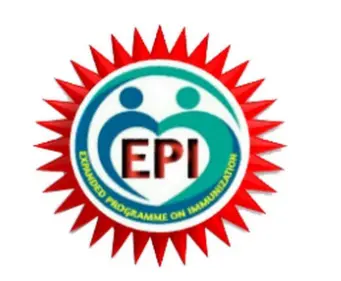
Overview of the Essential Programme on Immunization (EPI) and India's Universal Immunization Programme (UIP)
- Origin and Evolution
- Launched as the Expanded Programme on Immunization (EPI) by the World Health Organisation (WHO) in 1974.
- Evolved into the Essential Programme on Immunization, emphasizing universal access to life-saving vaccines.
- Diseases Covered
- Initially focused on six childhood vaccine-preventable diseases.
- Expanded to include a total of 13 diseases, such as BCG, diphtheria, pertussis, tetanus, polio, measles, etc.
- Recent additions include COVID-19, Haemophilus influenzae type B (Hib), and others.
- India's Universal Immunization Programme (UIP)
- Launched in 1978 as part of the EPI and renamed UIP in 1985.
- Objectives include rapidly increasing coverage, improving service quality, and establishing a reliable cold chain system.
- Monitoring of performance and achieving self-sufficiency in vaccine production are key goals.
- Eligibility and Coverage
- All beneficiaries, including pregnant women and children, can access vaccinations at government or private health facilities.
- Vaccinations are provided free of cost against 12 vaccine-preventable diseases.
- Nationally covered diseases include diphtheria, pertussis, tetanus, polio, measles, etc.
- Sub-nationally covered diseases include rotavirus diarrhoea, pneumococcal pneumonia, and Japanese encephalitis, with ongoing expansions for certain vaccines.
Source: TH
La Cumbre Volcano and Galápagos Land Iguanas
In News: Recent volcanic activity from La Cumbre volcano on the Galápagos Islands has led to the destruction of habitat for rare land iguanas.

La Cumbre Volcano and Galápagos Land Iguanas
About La Cumbre Volcano:
- Location: Situated on Fernandina Island, the third largest island in the Galápagos archipelago.
- Geological Significance: Positioned directly atop the mantle plume or hotspot responsible for the formation of all Galápagos Islands.
- Distance: Located approximately 1,125 kilometers off the coast of mainland Ecuador and experienced its first eruption since 2020.
- Crater Features: Boasts a sizable crater or caldera at its summit, housing a permanent crater lake.
- Ecological Importance: The caldera lake serves as a habitat for various wildlife, including tens of thousands of Galápagos land iguanas that lay their eggs within it.
Key Facts about Galápagos Land Iguanas:
- Endemic Species: One of three land iguana species exclusive to the Galápagos Islands, alongside the Santa Fe land iguana and the Galapagos pink land iguana.
- Physical Characteristics: A large lizard belonging to the family Iguanidae, primarily herbivorous in nature.
- Mutualistic Relationship: Often seen hosting finches on their backs, which aid in removing ticks from between their scales.
- Behavior: Diurnal in nature, spending daylight hours foraging or basking on rocks, while resting in burrows at night.
- Conservation Status: Classified as Vulnerable by the International Union for Conservation of Nature (IUCN).
Source: WION
Patachitra Painting
In News: The pioneering female patachitra artists from the village of Naya in West Bengal have embraced online platforms to market their artwork, gaining global recognition and inspiring younger generations to continue in the profession.
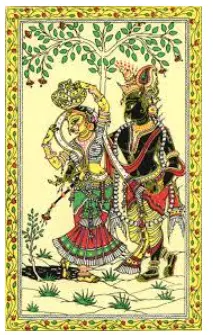
Overview of Patachitra Painting
- Definition and Origin:
- Patachitra, also known as Pattachitra, refers to traditional scroll paintings found in Odisha and West Bengal.
- Its origins can be traced back as early as the 12th century.
- Meaning:
- In Sanskrit, "Patta" signifies "cloth," and "Chitra" denotes "picture."
- Characteristics:
- Renowned for its intricate details, Patachitra paintings often depict mythological narratives and folktales.
- Hindu deities frequently feature in these artworks.
- Cultural Significance:
- Initially crafted for ritual use and as keepsakes for pilgrims visiting Puri and other Odisha temples.
- In Bengal, Patachitras were utilized as visual aids during musical performances.
- Process of Making:
- Patachitra paintings are created on a special canvas composed of cotton sarees coated with tamarind paste and clay powder.
- Both cotton and silk canvases are now used.
- Artists fill colors directly onto the canvas without preliminary sketches, starting with the borders.
- Natural sources like lamp soot and powdered conch shells provide the pigments.
- The creation of a single painting may take weeks or even months to complete.
Source: DTE
Look Out Circulars
In News: The Bombay High Court recently ruled that public sector banks (PSBs) are not authorized to suggest or request the issuance of Look Out Circulars (LOCs) against individuals who default on loans.
Overview of Look Out Circulars (LOCs)
- Definition and Purpose
- A Look Out Circular (LOC) is a directive issued by the government to immigration authorities, regulating the movement of individuals.
- It restricts individuals against whom the notice exists from leaving or entering the country.
- Usage and Enforcement
- Law enforcement agencies employ LOCs to prevent wanted or suspicious individuals from exiting or entering the country through designated ports.
- Typically issued by police, intelligence agencies, or other government bodies authorized by the Ministry of Home Affairs (MHA).
- Guidelines and Regulations
- Issuance of LOCs is governed by guidelines outlined in an Office Memorandum by the MHA in 2021.
- LOCs are permitted only in criminal or penal cases, with reasons for issuance explicitly stated.
- In exceptional cases, LOCs may be issued for reasons affecting India's sovereignty, security, bilateral relations, or strategic interests.
- Basic details such as name, passport number, and date of birth are necessary for issuance.
- Requests for LOCs must be continuously monitored to minimize inconvenience to genuine travelers.
- Review and Monitoring
- Originating agencies are responsible for quarterly and annual reviews of LOCs they request.
- Legal consequences of LOC issuance are transferred to originating agencies, as per the Passports Act, 1967.
Source: IE
Street Vendors (Protection of Livelihood and Regulation of Street Vending) Act, 2014
In News: It has been ten years since the Street Vendors (Protection of Livelihood and Regulation of Street Vending) Act was implemented on May 1, 2014.
Overview of the Street Vendors (Protection of Livelihood and Regulation of Street Vending) Act, 2014
- Purpose: The Act was enacted to legalize the vending rights of street vendors and regulate street vending in urban areas.
- Implementation Framework: It involves State-level rules and schemes, executed by Urban Local Bodies (ULBs) through by-laws, planning, and regulation.
- Roles and Responsibilities: The Act clearly defines the roles and responsibilities of both street vendors and various levels of government.
- Protection of Existing Vendors: The Act ensures the accommodation of all existing vendors in designated vending zones and the issuance of vending certificates (VCs).
- Participatory Governance: It establishes Town Vending Committees (TVCs) to facilitate participatory governance, with 40% of members representing street vendors, including a sub-representation of 33% for women vendors.
- Functions of TVCs: TVCs are responsible for ensuring the inclusion of all existing vendors in vending zones.
- Grievance Redressal Mechanism: The Act outlines mechanisms for addressing grievances and disputes, proposing the establishment of a Grievance Redressal Committee chaired by a civil judge or judicial magistrate.
- Vendor Identification Survey: States/ULBs are required to conduct surveys at least once every five years to identify street vendors.
Source: TH
Care Economy
In News: The article explores various dimensions of unpaid care work in India and emphasizes the necessity for a care economy that is more valued, inclusive, and equitable.

Constitutional Provisions Related to Working Women in India
- Article 14: Right to Equality
- This article guarantees that everyone is equal before the law and entitled to equal protection. It prohibits discrimination based on gender in the workplace, ensuring that working women have the same legal rights as men.
- Article 15: Prohibition of Discrimination
- Article 15 prohibits discrimination on various grounds, including sex, in areas such as public employment. It ensures that women have equal opportunities to access government jobs and are not discriminated against based on their gender.
- Article 16: Equality of Opportunity in Public Employment
- Article 16 guarantees equality of opportunity in matters of public employment. It protects women from being denied employment or facing disadvantages due to their gender, ensuring fair treatment in the workforce.
- Article 39: Directive Principles of State Policy
- Article 39 under the Directive Principles of State Policy includes provisions related to gender equality and workers' rights. It emphasizes that both men and women have the right to an adequate means of livelihood and advocates for equal pay for equal work, regardless of gender.
- Article 42: Directive Principles of State Policy
- Article 42 directs the state to make provisions for securing just and humane conditions of work and maternity relief. It mandates the state to ensure safe working environments and provide maternity benefits for women, recognizing the need for gender-sensitive policies in the workforce.
Care Economy: Understanding the Concept
- Overview of the Care Economy
- The care economy encompasses the provision of care and support services related to health, education, childcare, eldercare, and other forms of social care. It includes both paid and unpaid care work crucial for human survival, welfare, and labor force reproduction.
- Historical Perspectives on Unpaid Labor
- Historically, unpaid labor, particularly caregiving and domestic work performed by women within households, has been undervalued and often excluded from conventional definitions of "work." Feminist economists have critiqued this exclusion and advocated for recognizing and valuing women's contributions to the care economy.
- Feminist Economists' Critique
- Feminist economists have challenged traditional economic frameworks for failing to account for the significant contributions of unpaid care work to the economy. They argue that caregiving and domestic work are essential for social reproduction and should be valued and supported by policies and institutions.
- Beijing Platform for Action
- The Beijing Platform for Action, adopted at the Fourth World Conference on Women in 1995, recognized the importance of unpaid care work and called for its recognition and redistribution. It advocated for policies and measures to support women's roles in caregiving, domestic work, and volunteerism, aiming to achieve gender equality and women's empowerment.
Source: IE
Share the article
Edukemy’s Current Affairs Quiz is published with multiple choice questions for UPSC exams
MCQ
Get Latest Updates on Offers, Event dates, and free Mentorship sessions.

Get in touch with our Expert Academic Counsellors 👋
Frequently Asked Questions
UPSC Daily Current Affairs focuses on learning current events on a daily basis. An aspirant needs to study regular and updated information about current events, news, and relevant topics that are important for UPSC aspirants. It covers national and international affairs, government policies, socio-economic issues, science and technology advancements, and more.
UPSC Daily Current Affairs provides aspirants with a concise and comprehensive overview of the latest happenings and developments across various fields. It helps aspirants stay updated with current affairs and provides them with valuable insights and analysis, which are essential for answering questions in the UPSC examinations. It enhances their knowledge, analytical skills, and ability to connect current affairs with the UPSC syllabus.
UPSC Daily Current Affairs covers a wide range of topics, including politics, economics, science and technology, environment, social issues, governance, international relations, and more. It offers news summaries, in-depth analyses, editorials, opinion pieces, and relevant study materials. It also provides practice questions and quizzes to help aspirants test their understanding of current affairs.
Edukemy's UPSC Daily Current Affairs can be accessed through:
- UPSC Daily Current Affairs can be accessed through Current Affairs tab at the top of the Main Page of Edukemy.
- Edukemy Mobile app: The Daily Current Affairs can also be access through Edukemy Mobile App.
- Social media: Follow Edukemy’s official social media accounts or pages that provide UPSC Daily Current Affairs updates, including Facebook, Twitter, or Telegram channels.


